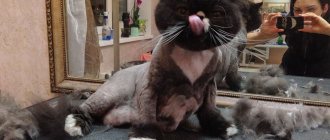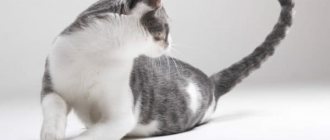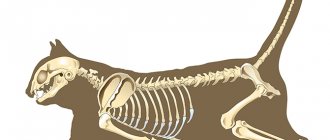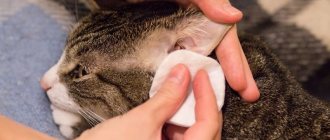Many owners wonder why their cats are shaking their tail. One of the main functions of this mobile and furry organ is communication, but it all depends on the specific situation.
Sometimes this behavior indicates health problems! Veterinarians recommend not to ignore frequent shaking and evaluate it together with the accompanying symptoms. Regardless of the true reason, this is a rather interesting experience that makes it easier to understand your pet.
Reason #1: tags
Whiskered pets leave their scent marks in order to attract the opposite sex and scare away competitors not only on horizontal surfaces, but also on vertical ones. To do this, they take a characteristic pose:
- maintain a straight body position and do not squat;
- point the tail straight up and spray a small stream of urine in the desired direction.
When marking territory, a slight tremor is explained by muscle tension that occurs involuntarily. Contrary to popular belief, not only males, but also females mark their territories. The only difference is that the latter do this less often, and their smell does not hit the nose so much.
“
In both cases, the situation is corrected by castration, but with one caveat. It does not eliminate the problem forever, but only reduces the likelihood of its occurrence.
Under certain circumstances, even castrati can mark. Most often this is explained by competition with a new pet who has not yet been neutered. The urine of these cats has a stronger odor and gives them a competitive advantage. Because of this, the spirit of rebellion awakens in the “old-timers”, and they again take up the old ways in order to prove their leadership qualities to the “newcomer”.
Main predisposing factors
In many cases, this can happen due to various infectious and parasitic diseases, as well as their consequences. The most common reasons are the following:
- Damage to the gastric mucosa.
- Similarly - ulceration of the mucous membrane of the thin and thick sections of the gastrointestinal tract.
- Peritonitis of infectious etiology.
- Inflammation of the mucous membrane of the small gastrointestinal tract.
- Parasitic diseases.
- Pyometra or endometritis (indicated by discharge from the genitals).
- Abscesses of internal organs (especially in the liver and pancreas).
In all these cases, such a strong pain reaction develops that the intestines literally “twist” from spasms. But disease or parasites are not always to blame for a cat’s suffering. There are reasons for non-infectious etiology:
- Tumors of benign and malignant etiology.
- Poisoning.
- Birth defects.
- Abdominal trauma in which internal organs were damaged, or a strangulated hernia.
- Abnormal pregnancy. Possibly torsion of the uterus.
- Pinched nerves (due to injury, or congenital cases).
- Stones in the kidneys, bladder, urinary tract.
- Gallbladder obstruction, liver or gallstones.
- Intestinal volvulus, but for cats, is an extremely rare pathology that is more typical for dogs.
Reason #2: passion for the hunt
Sharp twitching with swaying in different directions is typical for games with stationary objects and direct hunting of birds and rodents. In this way, the animal prepares for an attack and focuses on its prey.
Before the actual jump, you can see a peculiar wagging of the butt. This is necessary to distribute its own weight and calculate the flight path to the target.
IMPORTANT!
Discourage play with hands and feet. An older kitten can inflict very deep scratches without realizing the danger of its actions.
For homebody cats, chasing toy mice and teasing sticks replaces walks on the street. Thanks to regular active games, you can not only maintain your current weight, but also lose extra pounds. In the absence of contraindications, this method of losing weight is preferable, since reducing the usual portions leads to constant begging, theft, and waking up the owners in the middle of the night due to an acute feeling of hunger.
How to help your pet
Options for providing assistance to the injured animal are selected after establishing the exact cause of the pathological condition.
Removing wax plugs at home
The cat begins to shake its head if it is bothered by wax plugs. You can clean your pet's ears yourself. Saline solution or hydrogen peroxide will help in this situation. The selected product is instilled into the ear canal, 2-3 drops three times a day. The treatment course lasts 7 days. Subsequently, the animal usually successfully copes with this problem on its own.
If the cat is unable to remove the plug, the owner himself can remove it using a cotton-tipped swab or a piece of gauze. As a last resort, it is recommended to contact a veterinary clinic.
Surgical intervention
Surgery may also be recommended in cases of chronic otitis media, which results in narrowing of the ear canal.
Feline dermatitis
Has your cat started shaking his head all the time? Perhaps he has dermatitis. The disease is treated as follows:
- Remove the crust with a piece of cotton wool or gauze using hydrogen peroxide.
- Lubricate weeping ulcers with preparations with astringent properties (“Silver nitrate” 2%).
- Place drops containing novocaine into the ear canal. This will help relieve attacks of itching.
Continue treatment until symptoms disappear completely.
Fungal infections
If the fungus has entered the cat's ears, he begins to actively shake his head. In this situation you need to act like this:
- Every day, clean the ears with Chlorhexidine (0.05% solution).
- Give the animal the antifungal drug “Ketoconazole” for internal use, dose – 5 mg per 1 kg of cat’s weight. Take twice daily.
- Otibiovin drops will have an effective effect. They need to be instilled several times a day into the pet’s ear.
Fleas
If there are fleas, you need to start treatment immediately. The following steps will help get rid of parasites:
- The ear needs to be treated with a special preparation against parasites.
- After some time, clean the auricle from dead insects with a piece of cotton wool soaked in hydrogen peroxide.
- The entire cat should be thoroughly washed with flea detergent.
If necessary, the procedure must be repeated.
Ear scabies mites
This attack is treated with special antiparasitic and anti-inflammatory drugs:
- in the form of ear drops, ointment preparations (“Tactic” or “Amit”);
- in the form of injections (“Otodecnin”);
- Hydrogen peroxide and a soft tampon are used to remove purulent plaque in the ear.
Both ears must be treated at once, even if symptoms are found in only one.
How is notoedrosis treated?
Parasites must be combated with ointments and special detergents: tar, sulfur sediment, green soap.
In case of a particularly severe form of infection, use “Hyposulfite” and “Benzyl benzoate” to treat the affected areas.
If purulent formations appear, antibiotic treatment must be added.
Inflammation of the ear canal can be cured using a whole range of measures:
- if there is purulent discharge, it is removed with hydrogen peroxide and a piece of cotton wool;
- drops are instilled against otitis (Aurikan, Surolan, Oridermil, Oritsin, Bars);
- Novocaine is used to relieve pain (it is injected at the base of the animal’s ear);
- For allergic otitis, antihistamines are used.
For otitis media of a bacterial nature, the cat is treated with Otonazole, Mastiet, and Otibiovin. These are preparations for topical use.
Allergy in a cat
Animals, like people, also have allergies. Often such a reaction occurs to certain types of food or household chemicals. An allergy can be suspected if the cat shakes its ears, and at the same time its ears are clean. Treating such an ailment is simple: they use the same means that treat allergies in people (antihistamines for oral and local use).
Reason #3: communication
The cat's tail is the main mood indicator used when communicating with humans and other animals. It conveys the emotions of its owner using the angle of inclination and the intensity of the wobble:
- raised high and slightly trembling at the base - happiness;
- lying in a relaxed position or wrapped around the paws - calmness;
- arching and fluffy - fear;
- sharply wriggling and hitting the sides - anger.
The listed positions are necessarily accompanied by additional gestures. Because of this, it is better to give the final assessment in total, not forgetting about the ears, whiskers, paws, eyes and sounds made.
When communicating with a person, cats can shake their tail in response to their name, without pointedly turning their head in his direction. Usually at such moments they are busy resting and do not plan to leave the heated place in the near future.
The cat's tail is shaking... in his sleep
You've probably seen your pet purring when he's taking a leisurely nap. Or maybe you've noticed that his body, including his whiskers, paws and tail are shaking. According to scientists, this may mean that your little predator is dreaming of something interesting, for example, chasing his favorite toy or... a mouse.
However, this is not the only possible reason. A moving tail when a cat appears to be dozing may mean that the cat is not sleeping at all, but is simply relaxing. However, he is still aware of what is happening around him. Most often this happens when the cat is resting near the window, and very interesting sounds are heard outside.
Source
Reason #4: joyful excitement
A slight shaking of the tail is also characteristic of joy. At such moments, he is proudly raised “pipe”, and the cat itself purrs contentedly, rubs against objects and arches its back. The reaction is observed when meeting the owner after work, while waiting for food and immediately after feeding. You need to act according to the situation:
- Greetings. Be sure to pet your pet and pick it up if he doesn’t mind.
- Waiting for food. Here, you are only required to serve on time, as your legs may suffer due to the long wait.
- End of feeding. At the end of the meal, the cat tries to thank you for the delicious lunch, but you can also praise or pet it in return. Regularly receiving approval from the owner normalizes appetite. This is especially important for those who eat less than their norm.
A similar gesture is used to invite people to play. Due to excitement, the cat may shift from paw to paw.
Some animals openly declare their intentions and bring toys to their owner. This behavior should be encouraged. If you are busy, give your pet at least a few minutes. This will strengthen your connection.
Symptoms
Symptoms of feline hyperesthesia can develop at any age, and the condition can occur in all breeds. A cat that suffers from hyperesthesia syndrome may end up licking and biting its own body, such as its limbs, tail and back.
Slanimsky Alexey Georgievich
Veterinarian of the highest qualification category. Has extensive experience in diagnosing and treating diseases in animals.
Important! It is still not known for certain why this disease occurs, but it regularly burns nerve cells for cat breeders. As a rule, the manifestations of this pathology can be managed with sedatives, which your veterinarian can prescribe to the cat.
Here are some other signs that your cat may have hyperesthesia:
- The skin on your cat's back may range from the shoulders to the tail
- Your cat may suddenly jump and turn towards her tail as if something is bothering her
- You may notice muscle twitching, tail twitching, and/or muscle spasms
- Your cat may not like certain areas of its back to be touched when you go to pet it
- Your cat may act erratically, appear agitated, and have dilated pupils
- Your cat may cry, hiss, or suddenly run away, and you may think she's hallucinating because she looks like she's going after something that isn't there.
- Severe cases can lead to self-destruction through chewing, licking, fur pulling, and biting. As a result, lesions and infections may appear on the skin.
Typically, these symptoms occur in episodes that may last only a few seconds or a few minutes. In between episodes, your kitten will act as if everything is fine. However, touching your cat in the wrong place can trigger an episode.
Reason #5: irritation and anger
Rhythmic movements in different directions, accompanied by frequent and loud knocking on the floor, mean irritation. To calm your cat, you will need to find out what is causing her anxiety. Most often, animals are disturbed by large crowds of people, strangers in their own home, prolonged absence of the owner, loud sounds and strong odors.
Try picking up and cuddling your cat, then direct her attention to her favorite toys or treats. Remember that not everyone enjoys communicating with other people, so in such cases, a mustachioed pet needs a house where it can hide and be alone.
When very irritated and angry, the tip of the tail bends into a hook. In this state, it is better not to touch the cat. Instead, you should look for the sources of her discontent and try to eliminate them.
In addition to the position of the tail, the following signs will help recognize aggression:
- pressing the ears to the skull;
- arching the back;
- dilated pupils;
- snorting and threatening hissing;
- fluffy fur along the spinal column;
- release of claws;
- demonstration of teeth.
It is recommended to leave a frightened pet alone.
The same applies to the reaction to affection. Braking during sleep is not a good idea. Try to respect your pet's personal space and only pick her up if she has given her consent.
Sometimes anger is caused by unattainable objects: birds and other animals outside the window. In this case, aggression is redirected to what is nearby. A single attack on your legs due to an unsuccessful pigeon hunt is prevented by throwing a blanket and urgently taking the aggressor to another room. If such attacks become more frequent, consult a veterinarian. Sedatives may be required to suppress aggression.
When an animal gets angry
When a cat starts to get angry, the tail immediately signals her displeasure. One of the characteristic movements in this case is a sharp movement of the tail from side to side. It becomes like a metronome needle. At such moments, we can talk not about wagging the cat's tail, but about quickly shifting it back and forth. This shows that the pet is extremely irritated and should not be touched.
We invite you to familiarize yourself with Karsil for dogs: how to give, instructions, dosage and reviews
The more furiously the cat wags its tail, the more caution the owner should exercise. Especially if the fur rises along it, and the pendulum movement is accompanied by the guttural sounds of a cat or a menacing hiss. If you don't leave the animal alone, it may attack. And these will not be ordinary scratches received when playing with a pet, but real wounds. Sometimes they lead to serious consequences for humans.
Thus, scientists have identified a disease that is called cat scratch disease or scientifically called felinosis. Being angry, a pet can deeply wound its owner and, through saliva, introduce an infection (Bartonella) into his blood. When the virus enters a person’s blood, intoxication of the body is possible, the symptoms of which are:
- enlarged lymph nodes;
- headache;
- feverish condition;
- lack of appetite;
- inflammation of the skin.
Another reason for sudden tail wagging may be the cat's readiness to hunt. While in nature, it patiently tracks down prey, and when it approaches, it takes some time to prepare to jump. At this time, the animal begins to flail its tail and actively wag it. When playing in an apartment, it may mistake a toy for a live mouse, or actually see some kind of “domestic” insect - a moth, a fly or a cockroach. Then the rapid wagging of the tail will be caused by the hunting instinct, and not by aggression or anger.
Reason #6: itching in the lower back
Sometimes owners are puzzled by why the cat twitches and shakes its tail, but does not mark. The simplest explanation for this behavior is severe itching. In both cases, there is indeed a slight contraction of the back, but if your pet has scabies, it is recommended to check for ectoparasites, that is, lice eaters, ticks and fleas.
In addition to itching, the main symptoms of infection include:
- constant scratching;
- hair loss, brittleness and dullness;
- partial or complete loss of appetite;
- the formation of ulcers and scabs at the site of scratched bites;
- moving black spots on the body;
- sleep disturbance;
- apathy or anxiety;
- reduction in body weight.
An animal with these symptoms should be seen by a veterinarian. Otherwise, complications may develop.
Another possible explanation for back contraction is rapid bowel movement. This is normal, but only if the pet goes to the toilet consistently.
Problems with bowel movements, accompanied by restlessness, poor appetite and plaintive meowing, may indicate constipation. The help of a veterinarian is also required here, since prolonged accumulation of feces can lead to intestinal rupture.
In addition to ectoparasites, a cat can be bitten by stinging insects: wasps or bees. The main danger of such bites is the presence of an allergic reaction to saliva. Regardless of the severity of the condition, the bitten pet should be taken to a veterinary clinic to prevent the development of anaphylactic shock. It can be recognized by the following signs:
- blue or pale mucous membranes;
- difficulty breathing;
- rapid increase in swelling;
- the appearance of severe vomiting or foam from the mouth;
- fainting.
A similar condition can be caused not only by wasp or bee saliva, but also by other allergens: pollen, household chemicals, tobacco smoke, and some foods.
When skin reactions occur, allergies can easily be confused with dermatitis, so do not self-medicate and be sure to consult a veterinarian if you have any alarming symptoms.
Treatment
If your kitten begins to show signs of feline hyperesthesia syndrome, it is a great idea to talk to your veterinarian, who will evaluate your pet and rule out other problems that have similar symptoms.
If hyperesthesia is the cause of your cat's symptoms, it is important to know that there is no definitive cure for this condition. Instead, your veterinarian may recommend giving your pet prescription medications such as anticonvulsants or antidepressants. Reducing your cat's stress and anxiety levels through environmental enrichment may also be helpful, or you may be advised to make changes to your kitten's diet. Additionally, natural remedies such as acupuncture, massage, and supplements may also be recommended.
Why does a cat twitch the tip of its tail?
In some situations, the cat does not twitch its entire tail, but only the tip. Most often, this behavior is explained by preparation for an attack, doubts or research.
Reason #7: about to attack
It is quite easy to guess about an imminent attack if the pet is in plain sight. Before the actual jump, the tail actively flickers from side to side and trembles at the very tip.
Particular caution should be exercised if the attacker hits himself forcefully with his tail on the sides, arches his back and ruffles his fur, trying to appear larger than usual. This reaction is often accompanied by fear, and a frightened animal may inflict serious injuries in order to protect itself.
IMPORTANT!
Cats very rarely fight with each other. Unlike dogs, their wounds take a long time to heal, so receiving physical damage is not beneficial for them. They try to intimidate the enemy with an intimidating pose and loud howls.
Reason #8: doubts or investigates
Another explanation for why a cat twitches its tail may be doubt. Living side by side with humans, mustachioed pets adopt their habits. The simplest analogy is thoughtfully and unconsciously tapping your knuckles on a table or shaking your leg. Animals demonstrate their thoughts a little differently - with the help of a furry mood indicator.
If your pet randomly twirls and shakes its tail, slightly twitching the tip, be sure to take a closer look at other behavioral signs. The presence of doubts will be indicated by a complete lack of emotion.
At such moments, only one part of the body is active. The same applies to sounds. You can only notice concentration on some object or, conversely, a look into nowhere.
It is quite simple to get your pet out of the described state - you need to help him make a choice. The problem is that the reason for brooding is not always obvious. The simplest option is the proximity of a bag of food or another equally interesting item. If your pet is famous for its obedience, then without receiving approval, it will simply hypnotize the treats, not daring to sniff them closely.
Diagnosis
By the way, how can you tell if your cat has abdominal cramps? Unfortunately, there are enough external signs of this: the animal may “scream” in a voice that is not its own, lie writhing in pain, and in milder cases, vomiting is observed. Severe profuse diarrhea cannot be ruled out. If something like this is observed when you try to go to the tray “in a small way,” then you are probably dealing with kidney spasms.
On the way to the veterinarian (and you need to take your cat there urgently), think about what the animal ate and drank before the attack began, whether it is suffering from any infectious diseases, whether the cat could have eaten a poisoned mouse, etc. The more data you can give the doctor, the greater the chance of identifying the problem as quickly as possible.
A biochemical and complete blood test is done, and a urine test is taken. In addition, those diagnostic techniques that allow you to examine the abdominal cavity and its organs “from the inside” are of great importance. These include radiography and ultrasound.
Pathological signs
Minor rare scratching (2-3 times a day) and head shaking cannot be called odd: all living organisms scratch and shake their heads, cats are no exception
But if the cat begins to itch constantly and at the same time tears his ears with his paws with all his might, you should pay special attention to this. These symptoms are often accompanied by other alarming signs that should alert the pet owner
These are the signs:
- The animal behaves restlessly, gets irritated and nervous for no reason.
- The cat actively shakes its head, tilts it down or to the side.
- When scratching its ears, the pet emits a hiss or an angry purr, and meows pitifully and loudly.
- Scratching left bloody marks inside and around the ears.
- The cat is trying to rub its muzzle and ears on everything around it.
- It is possible that the cat's body temperature may increase.
- The animal does not allow its ears and head to be touched, reacting painfully to any touch.
- The inner surface of the ear becomes red or swollen.
- Various discharges flow from the ear.
- Brown crusts and ulcers appeared in the ear.
Have you noticed this behavior in your cat? So it's time to see the vet.
Attract attention
It is also possible that the animal has this behavior because it is jealous
the arrival of a new person in the house. Cats are very territorial and don't take change well, so if a child arrives or sees a new animal in your home, it's best to spend some time introducing yourself and letting your cat get used to this new presence.
In this sense, the animal will bite its tail only to attract attention
Although they are very independent, the truth is that they place great importance on love and want to feel loved. Therefore, if they feel that you are paying attention to other members, they may act in this peculiar way
The cat's head is twitching - is this a reason to contact a specialist?
Owners of four-legged pets sometimes notice characteristic head twitching. Pets can make such movements absolutely naturally and consciously. In some cases, small movements are involuntary and indicate a pathological condition of the animal that requires attention and treatment.
When a cat's head twitches, it may just be getting ready to jump. Such movements are typical for a furry pet before concentration and sudden action. At the same time, you can notice that the cat presses itself to the ground and begins to twist its croup (it may not twist), the animal’s eyes rotate with concentration following the object of interest to it, and its head makes small movements similar to shaking. Head shaking during sexual arousal is not a deviation either. The cats begin to jerk their heads slightly, and then the shaking is transmitted throughout the body. But if the animal does not have the above signs, then tremor may indicate developing pathologies.
Shape matters
The cat's “fifth limb” can have different configurations and lengths:
- the Thai has an oblong thin tourniquet (25-35 cm);
- the Persian has a short, luxurious fan (20-25 cm);
- the bobtail has a short, almost round pompom (5-13 cm);
- the Cymric has a barely noticeable stump (2-5 cm).
Moreover, in all cats, the tails consist of several (from 2 to 27) vertebrae, connected by a jelly-like joint fluid. The presence of “lubricant” explains, from a biochemical point of view, why cats wag their tails.
The shape of the outermost caudal vertebra is fundamentally important for the exhibition life of representatives of the cat family. The slightest deformation - knot formation, bending, kink, crease - will not allow the meowing contestant to pass the strict judicial selection.











